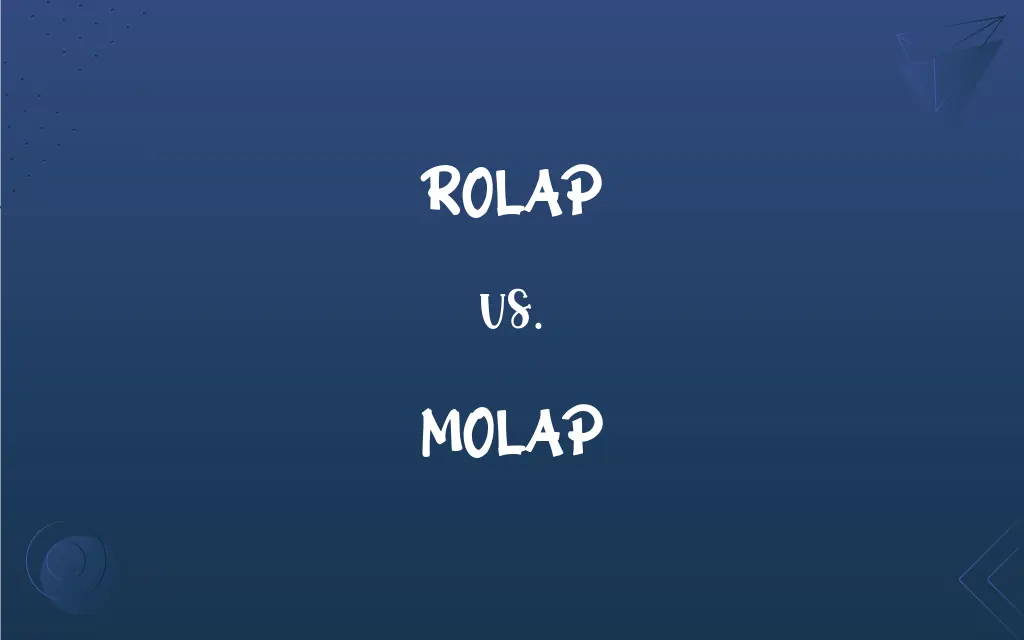ROLAP vs. MOLAP: What's the Difference?
Edited by Aimie Carlson || By Janet White || Published on February 23, 2024
ROLAP (Relational OLAP) operates on data stored in relational databases, while MOLAP (Multidimensional OLAP) uses multidimensional array storage.

Key Differences
ROLAP, or Relational Online Analytical Processing, works directly with data stored in relational databases. It's designed to handle vast amounts of data across various tables using SQL. MOLAP, or Multidimensional Online Analytical Processing, stores data in a multidimensional cube format, optimizing for fast retrieval of complex queries.
ROLAP can typically handle larger data sets as it relies on the scalability of relational databases. However, query performance might be slower compared to MOLAP, especially for complex calculations. MOLAP provides faster query performance due to its pre-calculated data but may face scalability issues with extremely large datasets.
With ROLAP, complex queries can be executed but may require extensive SQL knowledge and might run slower. MOLAP excels in executing complex, multidimensional queries rapidly, but its functionality is often constrained by the pre-defined data model of the cube.
ROLAP offers deep data analysis capabilities, as it can access detailed data levels in relational databases. MOLAP, while efficient in analysis, is often limited to the data aggregated in the cube, which may not include all detailed levels.
ROLAP is more suited for real-time data analysis, as it can query current data in relational databases. MOLAP often involves data being processed and stored in cubes beforehand, which might not reflect the most current data state.
ADVERTISEMENT
Comparison Chart
Data Storage
Relational databases
Multidimensional cubes
Query Performance
Slower for complex queries
Faster for pre-calculated data
Scalability
High, suitable for large datasets
Limited by cube size
Data Analysis Depth
Access to detailed data
Limited to aggregated cube data
Real-time Analysis
More capable
Less capable due to pre-processing
ADVERTISEMENT
ROLAP and MOLAP Definitions
ROLAP
Ideal for large data sets.
For their massive dataset, they implemented a ROLAP solution.
MOLAP
Relies on pre-calculated data for analysis.
MOLAP's pre-calculated cubes made yearly sales analysis faster.
ROLAP
Supports flexible querying with SQL.
ROLAP was chosen for its ability to handle dynamic SQL queries.
MOLAP
Stores data in multidimensional arrays.
MOLAP was used for its efficient data cube storage.
ROLAP
Provides real-time data access.
ROLAP enabled real-time sales analysis from the relational database.
MOLAP
Focused on aggregated data analysis.
MOLAP was perfect for analyzing high-level sales trends.
ROLAP
Analyzes data in relational databases.
The company used ROLAP for complex data analysis from their SQL database.
MOLAP
Offers fast performance for complex queries.
They preferred MOLAP for quick query responses.
ROLAP
Allows in-depth exploration of data.
With ROLAP, they could drill down to transaction-level details.
MOLAP
Faces limitations in scalability.
The large data volume posed scalability challenges for their MOLAP system.
FAQs
Which is better for large datasets, ROLAP or MOLAP?
ROLAP is typically better for larger datasets.
What is the primary storage type for MOLAP?
Multidimensional cubes.
Can MOLAP handle detailed data analysis?
MOLAP is more limited to aggregated data in cubes.
What does ROLAP stand for?
Relational Online Analytical Processing.
Can ROLAP handle real-time data analysis?
Yes, ROLAP is suitable for real-time data analysis.
Does MOLAP support real-time data updates?
MOLAP is less efficient with real-time updates due to pre-processing.
Is MOLAP faster than ROLAP for queries?
Generally, MOLAP is faster for pre-calculated queries.
Is SQL knowledge essential for ROLAP?
Yes, SQL expertise is important for ROLAP.
Does MOLAP require data pre-processing?
Yes, data needs to be pre-processed and stored in cubes.
How does MOLAP handle complex queries?
MOLAP efficiently handles complex queries with pre-calculated data.
How does ROLAP impact query performance?
ROLAP may have slower query performance for complex analyses.
Can ROLAP work with non-relational data?
ROLAP is primarily designed for relational databases.
What type of analysis is ROLAP best suited for?
ROLAP is best for in-depth, detailed data analysis.
Can MOLAP be used for predictive analysis?
MOLAP can be used but within the constraints of cube data.
Is ROLAP scalable for growing data?
Yes, ROLAP is scalable with relational database growth.
Are MOLAP cubes customizable?
MOLAP cubes are somewhat customizable but within limitations.
Can MOLAP analyze data beyond cube aggregation?
MOLAP is generally limited to the scope of the cube's data.
Is ROLAP suitable for small-scale data?
ROLAP can be overkill for small datasets.
How often are MOLAP cubes updated?
Update frequency varies but often involves batch processing.
Does ROLAP integrate well with existing databases?
Yes, ROLAP integrates well with existing relational databases.
About Author
Written by
Janet WhiteJanet White has been an esteemed writer and blogger for Difference Wiki. Holding a Master's degree in Science and Medical Journalism from the prestigious Boston University, she has consistently demonstrated her expertise and passion for her field. When she's not immersed in her work, Janet relishes her time exercising, delving into a good book, and cherishing moments with friends and family.
Edited by
Aimie CarlsonAimie Carlson, holding a master's degree in English literature, is a fervent English language enthusiast. She lends her writing talents to Difference Wiki, a prominent website that specializes in comparisons, offering readers insightful analyses that both captivate and inform.































































